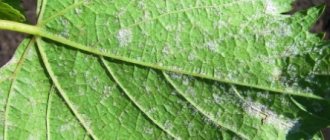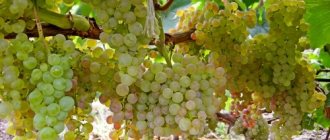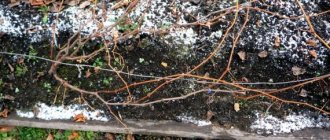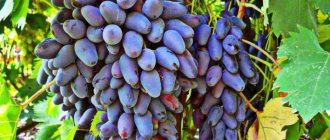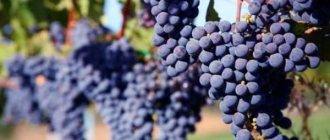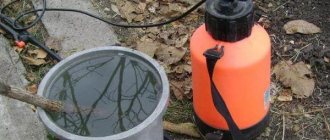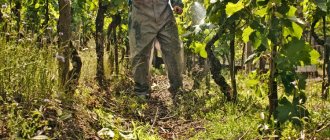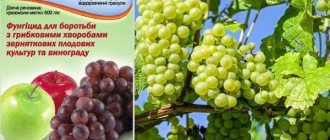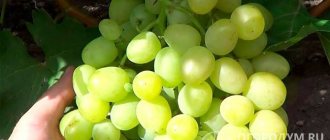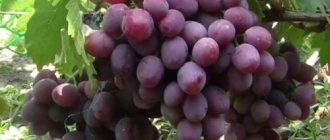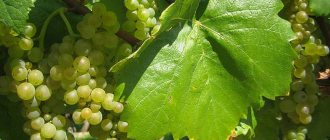Grapes Rhombik
When hearing the word grapes, many gardeners in temperate latitudes still imagine mainly the luxurious fruit-bearing vines of the southern regions.
And if grapes grow on someone’s plot in the middle zone, then the imagination imagines powerful shoots of Amur or maiden grapes, which serve perfectly as decoration for walls or fences. It is quite difficult to imagine grapes producing berries of good dessert taste in the middle zone, and this fact seems incredible even to experienced gardeners. However, this is becoming possible thanks to the emergence in recent years of new very early hybrid forms of grapes, the ripening time of which is already approaching 100 days and may be even shorter. Judging by its description of the variety and reviews about it, the Rhombik grape, for example, has such characteristics, a photo of which you can see below.
Actually, it is not yet a variety, but it would be more correct to call it a hybrid form of grapes undergoing testing. Since it appeared almost a few years ago, it has not yet become widespread among gardeners, although it has interested many enthusiastic winegrowers with its interesting characteristics.
History of the origin of the variety and its description
The Rombik grape is the creation of the famous wine breeder Evgeniy Georgievich Pavlovsky. Having been involved in viticulture since 1985, he has developed dozens of the most diverse and interesting hybrid forms, many of which have been tested and grow in private and industrial gardens.
Perhaps the main advantage of this hybrid form is its extremely early maturation. The grapes begin to ripen 80-90 days after the start of the growing season. Even experienced winegrowers have a hard time believing this, however, this fact has already been confirmed by many gardeners. Many winegrowers confirm that by the very beginning of August, the grape bunches not only have time to fully ripen, but are even slightly overripe on the bushes and begin to raisin. The video below clearly illustrates this fact.
And the ripening of Rombik grape bunches begins in mid-July. In some southern regions, ripening dates may even shift to the beginning of July.
Grape bushes of this form have strong growth energy, are distinguished by the massive size of the bushes, and the shoots branch well. To avoid overloading the bushes with the harvest, it is necessary to normalize the inflorescences. You can leave a maximum of two brushes on one vine.
The vine has time to fully ripen to its entire length during the growing season. Cuttings of this grape form have good rooting.
The fruits can be left hanging on the vine even after ripening. They begin to dry directly on the bush and gradually turn into raisins. Some people like this taste of grapes even more than fresh. They consider it more delicate and piquant.
Regarding wasp damage, reviews from winegrowers differ - some claim that they use a protective net against wasps, while others claim that this hybrid form of grapes is practically not damaged by wasps.
Regarding the yield, the description states that Rombik is a high-yielding form, but so far no one has been able to provide verified clear data on this matter.
This hybrid form is highly frost-resistant; the bushes can withstand down to -23°C. This fact may contribute to the spread of Rombik grapes in relatively more northern latitudes. Although it is necessary to cover it for the winter. But due to the early stages of ripening, it will have time to ripen at the latitude of the Moscow region and even to the north.
This hybrid form of grapes is characterized by fairly high resistance to many diseases characteristic of grapes, which is confirmed by numerous reviews. Therefore, treatments against diseases can be purely preventive.
Fruit characteristics
This hybrid form of grape received its name for the original shape of the fruit, which is, in a sense, unique. But this grape has other characteristics that distinguish it from other forms.
- The brushes are characterized by a fairly regular conical shape, while the looseness of the bunches is average. That is, it cannot be said that the berries in the clusters are tightly packed together, but they do not have the ability to crumble in the hands, but quite hold their shape. This is very convenient for harvesting, since the brushes, after being removed from the vine, are optimally placed in the prepared container.
- The size of the brushes is quite large - each weighs on average from 500 to 1000 grams.
- A special feature of this form of grape is that the berries are firmly attached to the grapevine, so you don’t have to worry about the berries scattering or falling off during the ripening process.
- The berries are quite large in size, each weighing from 10 to 15 grams or even more.
- The shape of the berries, as is obvious from the name, really resembles a diamond slightly smoothed at the corners.
- When ripe, the berries turn dark purple and later become almost black.
- The berries contain a small amount of seeds.
- The skin is quite thin and cannot be felt at all when eaten.
- The flesh is also dark and has an attractive crunch.
- The taste of the grapes is moderately sweet, harmonious with very original fruity tones.
- Rhombik grape berries are characterized by good commercial qualities and are quite suitable for transportation.
- Cracking of berries is usually not observed.
Advantages and disadvantages
Of course, the main advantage of this form of grape, as noted above, is its very early ripening. There are also other advantages that allow winegrowers to turn their attention to Rombik.
- Attractive appearance of berries and atypical taste;
- High resistance to diseases;
- Durable for transportation.
Among the shortcomings, one can note only the relative youth of the hybrid, which does not allow us to give stable recommendations for its cultivation. Some winegrowers also note insufficient sugar content in the berries and small clusters.
Agricultural technology
After properly planting the seedlings, you will have to constantly pay attention to the plant and provide it with regular care.
Irrigation
In the first two months, the plant develops intensively, so it requires abundant, regular watering. Then the frequency is reduced, since the shoots need to stop growing and have time to ripen before frost.
Top dressing
To prevent the ovaries from falling off, foliar feeding with boric acid is carried out. It is carried out before the flowers bloom and after the formation of fruits.
In spring, it is recommended to feed an adult plant with bird droppings.
Forming the vine and tying it to the posts
A vertical support is installed in advance, since the variety is tall. Pruned in the autumn, before sheltering for the winter. This will rejuvenate the plant and increase future productivity.
Seasonal processing
In the spring, they are treated with copper sulfate, which prevents the development of fungal diseases.
Flowering and fruiting period
Fruits begin to ripen on the 80th day, and in large quantities - on the 90th day. Usually in mid-July. Flowering - early May.
Growing Rombik grapes
Rhombik is a promising hybrid grape variety bred by breeder Pavlovsky. The Rhombik grape gained popularity due to its low maintenance requirements, excellent yield and surprisingly short ripening time.
Growing Rombik grapes
Characteristics of the variety
The most expressive features of the Rhombik grape variety are its early ripening and abundant harvest. Ripening lasts 80 days.
- frost resistance (Rombik can withstand cold temperatures down to -25°C);
- resistance to many diseases; resistance to pests with timely prevention;
- The harvest, when fully ripe, does not crack and tolerates transportation well.
Description of the bush
The bushes of the crop are tall, bulky and branchy. Thanks to the bisexual flowers, the plant has no problems with cross-pollination. The vines are fruitful.
The bunches have the shape of a cone. The looseness is average, which allows you to remove the bunch without loss or damage to the crop.
Description of berries
According to the description, the fruits are large and diamond-shaped. The color is dark purple, and when ripe, deep black. The weight of grazi is from 500 g to 1 kg, the berries are 10-15 g. The crispy pulp is moderately sweet and dark in color, the skin is almost not felt.
Growing
According to the description, when planting Rombik grapes, both seedlings and cuttings are used. After choosing a seedling, they find a place for the future grapes. It should be well lit, sunny and protected from draft winds. The holes are dug to a depth of 50-80 cm.
Simply burying a seedling is not enough. Drainage is made for it: a layer of crushed stone or scrap is covered at the bottom of the pit. The top is covered with a layer of soil, but with organic fertilizers. This will provide food for the culture for the coming years.
The roots need to be cleaned - cut off by a few millimeters, and then left in clean warm water for 2 hours. Next, the remaining soil is filled in, a hole is made on top, into which the crop is placed. After finally sprinkling the soil on top, compact it carefully and carefully, then water it with warm water. In addition, the soil is covered with mulch: dry leaves or straw.
The plant is tall, so it is necessary to immediately install vertical supports for it. They must be strong to support the weight of the crop.
Caring for plants is easy
There are no special care requirements for the Rhombik grape variety. While the plant has not yet grown much, it is better to protect it from frost by sprinkling it with sand, and sprinkle the wet soil with dry soil. As an option, make some kind of greenhouse: install vertical supports on the ground, cover them with film: this will prevent the soil from drying out.
Growing Rhombik grapes are fed. Organic fertilizers are great: bird droppings, compost, rotted plants and manure. Before flowering and after the final formation of the crop, the plant needs foliar feeding with boric acid.
When it gets warm, the plant is sprayed with copper sulfate. This will avoid fungal diseases.
The shelter should be removed when consistently warm weather sets in.
The plant only needs additional water at the beginning of the growth period. Then the amount of watering is reduced: it is better for the vine to fully ripen before frost.
According to the description, pruning is carried out in the fall, before the onset of frost, which allows for increased fruitfulness. In the summer, be sure to pluck out the shoots and break out damaged and weak shoots.
Diseases and pests
This type of grape is highly susceptible to powdery mildew. It affects the green parts of the plant. A grayish coating appears on the leaves and branches, and they acquire a rotten smell. To combat the disease, the plant is treated with the drug “Flint” or “Quadris”.
Mildew appears as a yellow and green coating on the leaves. If the plant is not treated, they begin to fall off. To prevent this, the vineyard is provided with good ventilation, and weeds and affected leaves are promptly removed.
Like all early varieties, the crop is susceptible to anthracosis. During illness, leaves and berries fall off. The treatment is simple: the plant is treated with Bordeaux mixture.
Diseases and pests
This type of grape is highly susceptible to powdery mildew. It affects the green parts of the plant. A grayish coating appears on the leaves and branches, and they acquire a rotten smell. To combat the disease, the plant is treated with the drug “Flint” or “Quadris”.
Mildew appears as a yellow and green coating on the leaves. If the plant is not treated, they begin to fall off. To prevent this, the vineyard is provided with good ventilation, and weeds and affected leaves are promptly removed.
Like all early varieties, the crop is susceptible to anthracosis. During illness, leaves and berries fall off. The treatment is simple: the plant is treated with Bordeaux mixture.
General characteristics of Rombik grapes
Diamond grapes are not the most popular grape variety today. Obviously, this is due to the fact that “Rhombik” is a young hybrid form of selection and has not yet had time to earn the love of winegrowers. This wonderful plant not only saves a hot summer day from the sun, but can also pamper you with juicy and sweet fruits.
There are a huge number of grape varieties. Winegrowers are increasingly interested in those types of selection that will be unpretentious in care and at the same time produce a prolific harvest. In this article we will look at the underrated Rhombik grape variety. On the Internet you can see photos of the Rhombik grapes and evaluate their excellent external characteristics.
Description of the new selection
Below is a description of the “Rombik” variety. Thanks to the development of new unpretentious hybrid selections, viticulture is becoming popular even in those regions where it was difficult to obtain a good grape harvest. Now, in regions not very suitable for viticulture, you can get a decent harvest.
This grape variety has an early ripening period of 80 to 90 days. Ripening time occurs in mid-July. The variety is vigorous and high-yielding. The berries are large, diamond-shaped, and the color ranges from dark purple to black. The weight of one berry usually reaches from 10 to 14 g. The pulp is crispy, juicy, sweet, the taste is harmonious with notes of dried prunes and black currants. There is a tart tartness in the aftertaste, and the skin is edible. When overripe, it does not crack and is not affected by wasps. The weight of a ripe bunch can reach up to one kilogram.
The main advantages of the variety:
- preserves well during transportation;
- immunity to fungal diseases;
- frost resistance down to – 23 degrees;
- the stepson crop ripens earlier than the main crop of early varieties.
Planting grapes "Rhombik"
It is recommended to plant seedlings in a sunny place without drafts, around mid-April. During this period, the bush adapts perfectly to the new place. It is advisable to make sure that the soil has warmed up sufficiently in the place where you plan to plant diamond grapes. The soil should be warmed up by 15 cm or more. It is also necessary to provide drainage to avoid rotting during watering. The "Rombik" variety does not require long-term intensive treatment against pests.
Advantages
Many gardeners note that among the characteristics there are definitely more advantages than disadvantages.
The main advantages of the variety:
- very early maturation;
- high level of productivity;
- excellent taste;
- presentable appearance;
- suitability for long-term transportation;
- high degree of resistance to most diseases;
- high frost resistance of the bush.
The Rombik variety is not susceptible to diseases and pests.
There are few grape varieties that ripen so quickly . When deciding to grow grapes, gardeners most often choose this crop precisely because of this fact.
Despite the rich sweet aroma, Rombik is practically not attacked by wasps and other insects . Grapes often attract birds, but to prevent damage to the berries, mesh bags are placed on the grapes. Some summer residents claim that the taste of the fruit is vaguely reminiscent of the taste of prunes, and the sweetish smell spreads far beyond the vineyard.
Thanks to the unusual shape of the fruit, the grapes are extremely attractive to buyers , which brings a stable profit to the owner of the grape plantation, and earlier ripening allows the owner to be among the first on the market. The variety is characterized by maximum resistance to low temperatures - it can comfortably overwinter at a temperature of twenty-three degrees minus. Thanks to this fact, in the southern growing regions the bushes do not require covering.
Diamond
| Ripening period | super early (85-95 days); |
| Flower functionality | bisexual; |
| Bunch weight | 500-700 g; |
| Berry weight | 10-14 g; |
| Taste | harmonious; |
| Bushes | vigorous; |
| Frost resistance | -23ºС; |
| Disease resistance | above average. |
Rombik is one of the earliest varieties in the vineyard today. It is the ultra-early ripening that is the main advantage of this hybrid form. Agree, who among us does not want to enjoy a refreshing berry in the middle of summer, when grapes can be found either in greenhouses or imported, and even then for fabulous money.
Origin of the hybrid form Rombik
It was obtained by the national breeder Evgeniy Georgievich Pavlovsky by crossing hybrid forms of grapes of his own selection, Super Extra and Krasotka. In this way, the breeder forms several generations of his own forms of grapes, the foundation for which, naturally, is proven, well-proven varieties.
The first working name was “seedling-4-2”, later - Rombik. If you pay attention, you will notice that the new hybrid has very few external similarities with its maternal forms. However, genetics is a complex science and sometimes you are surprised by its hereditary characteristics. One might assume that Rombik inherited very early ripening from Super-Extra and commercial qualities from Beauty, but does this really matter? The main thing is the characteristics of the new hybrid form and its future fate in our vineyards.
Main characteristics
The ripening period is ultra-early. The period from the moment the buds open until the berries are in full condition is approximately 80-90 days, which clearly sets Rombik apart from other grape varieties. Characterized by rapid sugar accumulation. The clusters are not very large; even from the first fruiting it became clear that it would be unlikely to get huge clusters, but they are elegant and neat. I think the maximum weight for bunches will be up to 1 kg, and the average is about 500 g. Pollination goes well, and the bunches turn out to be quite loose, which is also a definite plus.
The berry has a very beautiful rhombic shape, dark purple, almost black color and a medium-thick pruin coating. The weight of the berries varies on average 8-10 grams, which is a very good result for ultra-early grapes. The taste is harmonious, interesting with a characteristic fruity aftertaste and a faint nutmeg aroma. The pulp is quite dense with a hint of crunch, the skin is easily eaten, there are 1-2 small seeds inside. It cannot hang on the bush for a long time, as the berries begin to wither. Transportability is good, the berries do not fall off or get crushed. Resistance to major diseases and frost is still being studied. It can be assumed that frost resistance down to -23ºС and resistance to diseases are at the level of complex-resistant varieties.
Advantages and disadvantages
The main advantages of Rombik grapes include:
- very early ripening and rapid sugar accumulation;
- quite large and beautiful berry;
- high taste and tasting qualities.
I have not identified any disadvantages for myself. Perhaps not a large bunch, but for such a period of ripening this is an excellent indicator.
Conclusion
In the current situation, when new hybrid forms are growing like mushrooms and almost every winegrower is engaged in breeding, it is becoming increasingly difficult to identify the most promising ones. It is no longer possible to surprise with excellent taste and sky-high berries, and other indicators become a priority: ripening period, yield, stability and resistance to cracking of berries. The diamond is captivating, first of all, in its early stages, but other indicators need to be monitored for some more time in order to call the form promising.
Video of grapes "Rhombik"
This video was filmed at the vineyard of Shpak V.A. A young bush is presented on its own roots.
[adsp-pro-4]
Reviews from gardeners
Since the Rhombik grape form appeared quite recently, there are still few full-fledged reviews about this hybrid, but in general, gardeners confirm the declared characteristics, especially the early ripening periods.
Maxim, 43 years old, Belgorod
I planted my own Rombik last year. This year I have already received the first signal brush, which ripened in the 20th of July. The pulp of the berries is dense, I liked the taste - light nutmeg with a hint of fruit. Sugar content reached about 16. A bit like mulberry. The berry itself is beautiful, I didn’t notice any sores on the bush. By the way, Harold is planted nearby, so it ripens later, already in early August.
Valentin, 38 years old, Stavropol region
For now, due to lack of space, I grafted Rombik onto Doina’s bush. I did this last year, and already this season the first small clusters appeared. The overall feeling of the berries is good, but after a heavy downpour, some of the berries burst lengthwise. The wasps were quite annoying, so I had to throw a net.
Svetlana, 46 years old, Tambov region
I planted a Rhombik seedling two years ago. This year I finally got my first harvest. Of course, it was still quite small, about 1.5-2 kg per bush. But for me this is already a joy. The berries fascinated me, they crunch so wonderfully. Although some were clearly hanging on the bush and looked more like raisins.
The berries weighed from 5 to 9 grams, beautiful, with an unusual diamond shape. The taste is frankly sweet, with a subtle aroma and taste of something fruity, unlike grapes. I liked that the vine had time to ripen all before the cold weather. And, of course, unusually early ripening periods. Let's see what happens next, but for now I really like it.
Read more: How to calculate the distance between grape bushes when planting
I planted my own Rombik last year. This year I have already received the first signal brush, which ripened in the 20th of July. The pulp of the berries is dense, I liked the taste - light nutmeg with a hint of fruit. Sugar content reached about 16. A bit reminiscent of mulberry. The berry itself is beautiful, I didn’t notice any sores on the bush. By the way, Harold is planted nearby, so it ripens later, already in early August.
Rombik grapes will be a real find for beginning winegrowers who live north of the Rostov region. Possessing high disease resistance, very early ripening and an unconventional sweet taste, it will decorate any garden plot.
Andrey.
Grafted onto a Doina bush. The first clusters were small. The berries are large, but uneven, there are a lot of peas. After the rains they began to crack. Then they were attacked by wasps. Either I grow roofing felts so poorly, or it’s some kind of strange variety. I hope there will be no such “emissions” next year.
Alexei.
A year ago I planted Rombik. This year a signal appeared. Ripened by July 20th. The berry is dense and sweet. There is a slight taste of nutmeg and a hint of mulberry. During the growing period, no diseases were encountered.
Anastasia.
I love blue grape varieties most of all. I’m not a winegrower, I don’t have much experience, but in the yard, under a canopy, it’s Rombik that grows. Thanks to him, I don’t buy any grapes at the market. The taste is perfect, dense, crispy. The berries do not fall off. Wasps attack, of course, but if I were a wasp, such sweetness would also attack.
Valentina Mikhailovna.
I also want to share my review of this amazing variety. What I noticed while growing Rombik (5 years of growing experience). This is a very high-yielding variety, and it is almost impossible to spoil the harvest. The clusters are simply huge, up to 1 kg. The berries are medium, approximately 10 g. Initially, I was afraid to purchase this variety, since I had an unpleasant experience with Super Extra and Beauty.
Grape variety Rombik
Rombik is the newest hybrid form of table grapes, bred by the domestic folk breeder Evgeny Pavlovsky just a few years ago. Despite his amateur status, Evgeniy Georgievich is an experienced researcher, and over the long period of his creative activity he has already presented dozens of new varieties and hybrids to winegrowers. Some of them turned out to be so successful that they managed to pass the state variety test and were officially included in the State Register of Breeding Achievements of the Russian Federation. In the first years of work in the field of selection, Pavlovsky was provided with great methodological assistance by the most famous scientist in this field, Ivan Aleksandrovich Kostrikin, but even after his death, the national breeder continued the work he had begun, and never ceases to amaze us with the magnificent properties of his new products.
Bred as a result of crossing the famous Super Extra variety with one of Pavlovsky’s first works, Krasotka, Rombik turned out to be an ultra-early hybrid, capable of producing a harvest just 80-90 days after the start of the growing season. In addition, it is distinguished by a very good appearance of the bunch and excellent taste of ripe berries. There is still little information about the economic characteristics of grapes, but, according to the owners who are already cultivating the variety on their plots, they have not noticed any particular delicacy or pretentiousness for the plants.
The form is gradually gaining popularity among lovers from all over the country and neighboring countries, but it may be especially interesting for enthusiasts from the northern viticulture zone, where many other varieties and hybrids often simply do not have time to ripen.
General information about the variety
The grape called Rombik was bred by the famous breeder Evgeniy Georgievich Pavlovsky, who began breeding varieties for industrial and private gardens in 1985. Diamond appeared in 2010 after a breeder crossed the Krasotka and Superextra varieties.
The grapes “Arcadia”, “Tason”, “White Delight”, “December”, “Talisman”, “Victoria”, “Sensation”, “Valentina”, “Crimson”, “Augustine” are perfect for fresh consumption.
This variety ripens very early and accumulates sugar quickly. Ripe berries can be obtained three months after the buds open, i.e. somewhere in early July.
